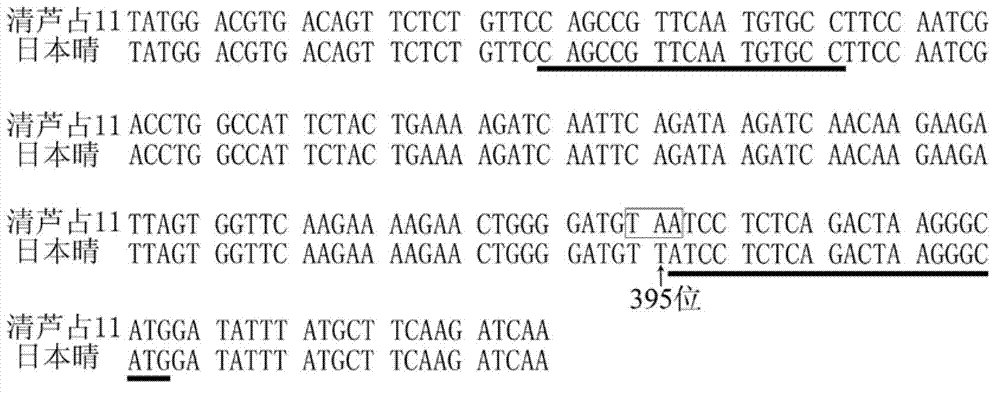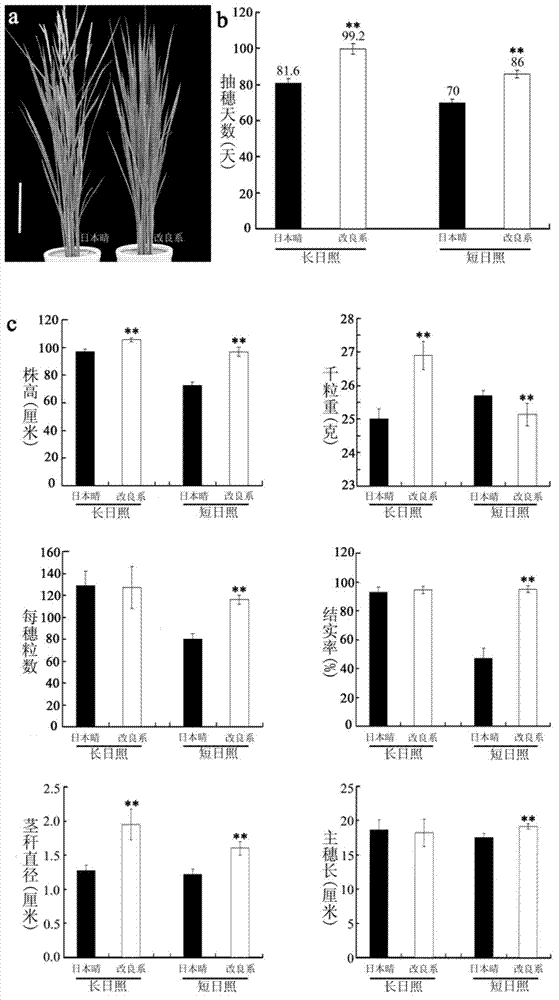Paddy Hd-q gene and application thereof in cultivation of paddy with wide applicability
A gene and rice technology, applied in the field of plant breeding, can solve the problems affecting rice yield and the complex way of rice yield
- Summary
- Abstract
- Description
- Claims
- Application Information
AI Technical Summary
Problems solved by technology
Method used
Image
Examples
Embodiment 1
[0016] Cloning and functional verification of embodiment 1Hd-q gene
[0017] In the previous study, we used the japonica rice variety Nipponbare as the recipient parent, and the indica rice varieties Qingluzhan 11 and Longtefu (provided by the Institute of Crop Science, Chinese Academy of Agricultural Sciences, see China Crop Germplasm Information Network http: / / icgr .caas.net.cn / ) etc. as donor parents, constructed a series of chromosome segment replacement lines. A replacement line C63 was found in the progeny of Qingluzhan 11, which showed delayed heading phenomenon under long-day sunshine conditions in Yangzhou summer or short-day sunshine conditions in Hainan winter. By crossing C63 with Nipponbare, F1 heterozygous plants were obtained, and the F1 plants showed normal heading. Genetic analysis was carried out on the F2 segregation population derived from F1 plants and the gene was initially located. Some plants were randomly selected from the F2 population, and it was fo...
Embodiment 2
[0021] Embodiment 2 Design and detection of dcaps1 molecular marker
[0022] According to Example 1, compared with the EF7 gene, there is a special single nucleotide variation site (hereinafter referred to as the SNP site) on the second exon of the Hd-q gene, specifically in the Hd-q gene The base at the 395th position of the coding sequence is A, and the corresponding position in EF7 is T. As a result, the Hd-q gene forms a stop codon at this position. According to this SNP, the specific dCAPS marker dcaps1 (upstream primer dcaps1-FSEQ ID NO.2 and downstream primer dcaps1-R SEQ ID NO.3) is used to find and verify this special site ( figure 1 ), the restriction endonuclease HpaI used can recognize the rice of the genotype of T at the SNP site (such as Nipponbare, called TT genotype), but cannot recognize the rice of the genotype of mutated base A (such as Qing Lu accounted for 11, known as the AA genotype).
[0023] The total rice DNA was amplified by PCR with primer dcaps1 ...
Embodiment 3
[0024] Example 3 Molecular marker-assisted breeding of new rice lines containing Hd-q gene
[0025] The present invention provides a way of thinking to use rice plants containing Hd-q genes (such as rice variety Qingluzhan 11) as donor parents, and rice varieties or strains to be improved (such as Nipponbare) as recurrent parents to carry out continuous backcross selection. education. In the low generation, the molecular marker dcaps1 linked with the target gene Hd-q gene and its delayed heading target traits in Example 2 is used for assisted selection, and can be selected in conjunction with the heading stage phenotype in the high generation population, after a certain period of time After one generation, new varieties or lines can be bred that not only retain the excellent traits of the original parent to be improved, but also have good regional adaptability.
[0026] The invention introduces the Hd-q gene into a japonica rice variety Nipponbare that has completed the whole...
PUM
 Login to View More
Login to View More Abstract
Description
Claims
Application Information
 Login to View More
Login to View More - R&D
- Intellectual Property
- Life Sciences
- Materials
- Tech Scout
- Unparalleled Data Quality
- Higher Quality Content
- 60% Fewer Hallucinations
Browse by: Latest US Patents, China's latest patents, Technical Efficacy Thesaurus, Application Domain, Technology Topic, Popular Technical Reports.
© 2025 PatSnap. All rights reserved.Legal|Privacy policy|Modern Slavery Act Transparency Statement|Sitemap|About US| Contact US: help@patsnap.com



